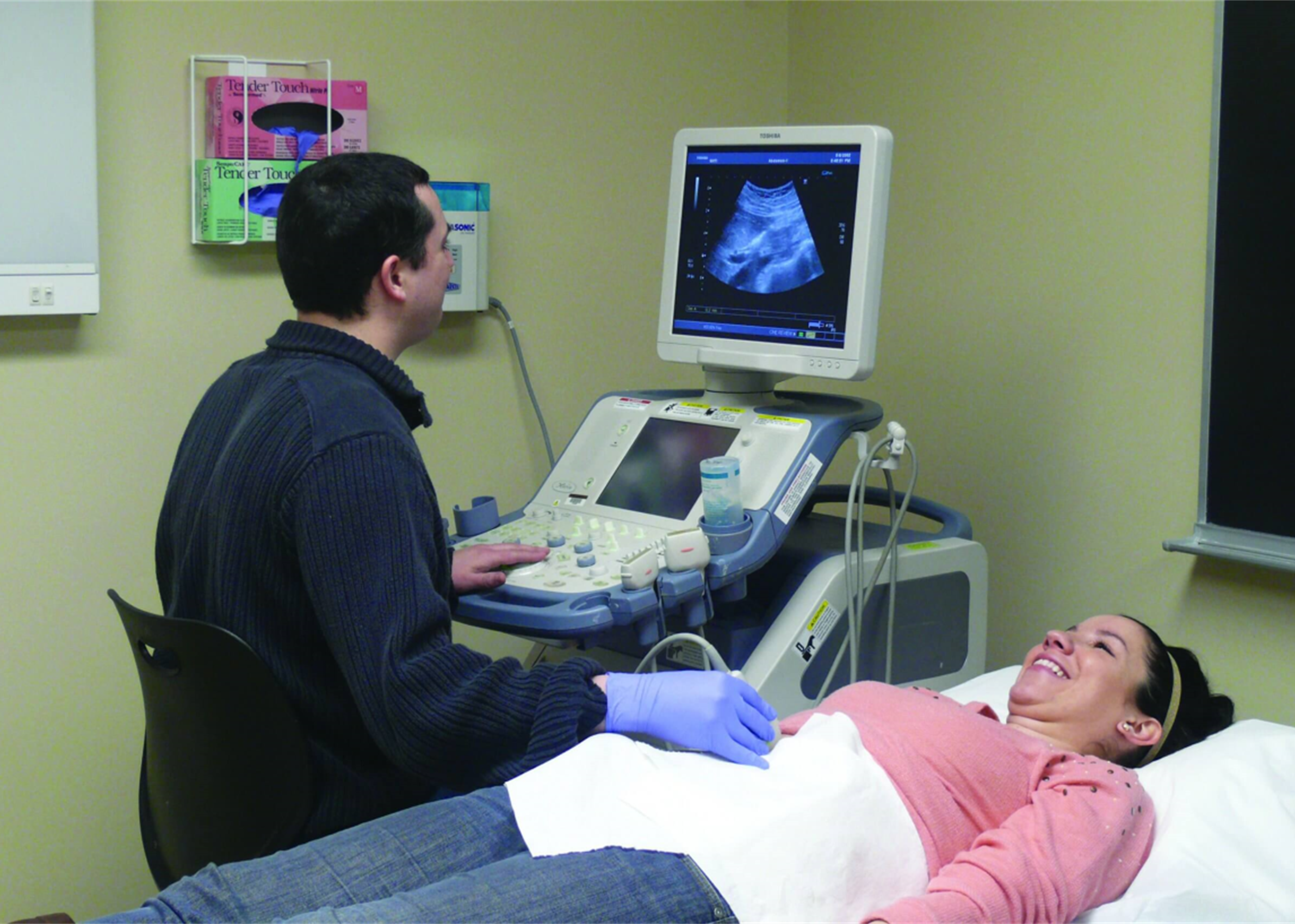NHTI's 16-month Diagnostic Medical Sonography certificate program provides you with the knowledge and clinical skills to function as a diagnostic medical sonographer. The program is designed for students who have completed an AMA Allied Health associate degree or a bachelor's degree.
Graduates provide exceptional patient care while using sophisticated ultrasound instrumentation to perform medical imaging procedures, which assist physicians in diagnosing medical conditions.
NHTI’s intensive program requires four semesters of full-time study of ultrasound specialties such as abdomen, small parts, obstetrics, and gynecology, plus an introduction to vascular sonography. Our small class and lab sizes provide extensive, supervised, hands-on practice. This program is financial aid-eligible.
Do you have questions? Contact Michelle Wade, program coordinator, at mwade@ccsnh.edu or 603-271-6484 x4108. The department chair for this program is Amy VonKadich, who can be reached at avonkadich@ccsnh.edu.
Apply for this program today on our Admissions page with step-by-step instructions and enrollment pathways build just for you!
Preference will be given to those whose applications are complete and received by the Admissions Office no later than the Admissions deadline for this program.
Admissions Deadline: January 9, 2026 through May 1, 2026, on a space availability basis
- Applicants must have completed a two-year AMA or AMA-equivalent Allied Health training program that is patient-care related such as Radiologic Technology or Nursing; Medical Assisting and an AS in Health Science are not considered AMA Allied Health programs. In lieu of the AMA Allied Health program, a bachelor's degree would also qualify for admission.
- The following college-level courses are required with a C or higher: Algebra, Statistics or higher-level math course; Anatomy and Physiology I and II with labs; Communications (may be met by courses including English, speech, or composition); general college-level Physics and/or Radiographic Physics
- A course in medical terminology is strongly recommended.
- A personal interview is required; qualified candidates will be contacted to arrange an interview.
- Two letters of recommendation, submitted to the Admissions Office.
- A completed course in BLS CPR from the American Red Cross, American Heart Association, or the National Safety Council. Online-only programs are not approved.
Graduates are prepared to take the national certification exam administered by the American Registry of Diagnostic Medical Sonography (ARDMS) and find employment in hospitals and private clinics.
First Year
Fall Semester
Spring Semester
Summer Semester
Second Year
Fall Semester
Accreditation
The DMS program is accredited by the Commission on Accreditation of Allied Health Education Programs upon the recommendation of the Joint Review Committee on Education in Diagnostic Medical Sonography.
- Commission on Accreditation of Allied Health Education Programs
9355 – 113th St. N, #7709
Seminole, FL 33775
727-210-2350
https://www.caahep.org/
Graduates are qualified to take national certification examinations with no additional work experience required.
Clinical Clearance
Background Checks
As a pre-clinical requirement, students are required to undergo and successfully meet the Diagnostic Medical Sonography department’s criteria for a criminal background check and drug and alcohol screening. No student is exempt. Students are provided with procedural and cost information subsequent to admission to the DMS program and are responsible for all costs associated with these testing procedures. Drug and alcohol screening is required prior to clinical and randomly throughout the program.
Clinical Affiliates
The program affiliates with clinical sites throughout N.H., Maine and Vt. Students rotate through sites throughout the program.
Essential Functions
The student must have sufficient strength and motor coordination to perform the following physical activities:
- Standing for sustained periods of time and walking most of the work day
- Frequent reaching and manual dexterity in handling equipment
- Frequently transporting, moving, lifting, and transferring patients from a wheelchair/stretcher to and from an exam table
In addition, the student must have:
- Sufficient eyesight to observe patients, manipulate equipment, and evaluate image quality
- Visual acuity sufficient to work with analyzing data, figures, and computer terminals involving small defects, small parts, and operation of equipment
- Sufficient hearing to assess patient needs
- Sufficient writing skills to communicate needs promptly and effectively
- Ability to express or exchange ideas to convey detailed or important spoken instructions to patients, physicians, families, and other employees accurately, loudly, and/or quickly
- Ability to work with frequent interruptions and respond appropriately to unexpected situations
- Ability to work with wide variations in workload and stress levels
Applicants who feel they may not be able to meet one or more of the essential functions should contact program officials to discuss individual cases. Program officials will consider all academically qualified candidates providing that the essential functions can be met with reasonable accommodations.
Program Effectiveness Data
Program Learning Outcomes
Graduates from this program are able to:
- Obtain, review, and integrate pertinent patient history and clinical data to facilitate diagnostic results.
- Perform appropriate sonographic procedures and record, analyze, and process diagnostic data for presentation to the interpreting physician.
- Demonstrate knowledge and understanding of anatomy, physiology, pathology, and pathophysiology.
- Demonstrate knowledge and understanding of acoustic physics and instrumentation including Doppler principles and emerging technologies.
- Employ ergonomically correct scanning techniques and the principles of ALARA.
- Exercise discretion and judgment in the performance of sonographic and/or other diagnostic services.
- Demonstrate effective and appropriate communication skills with patients and colleagues.
- Provide basic patient care and comfort while acting in a professional and ethical manner.


